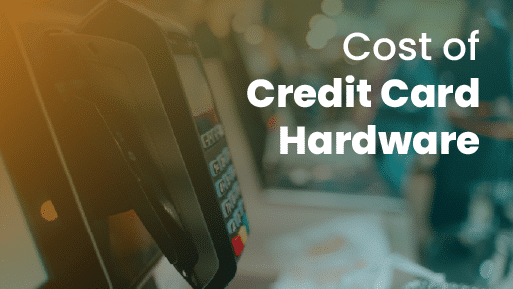? Key Takeaways:
- Upfront costs vary widely: Credit card machines range from $0–$100 for mobile readers to $300–$1,800 for POS systems, with some providers offering free terminals under processing contracts.
- Transaction fees impact profitability: Fees typically range from 0.8%–1.75% for in-person transactions to 2.9%–3.5% for virtual terminals, with high-volume businesses benefiting from interchange-plus pricing.
- Hidden and monthly fees add up: Watch for setup, PCI compliance, or cancellation fees, and expect $0–$200/month for software subscriptions, especially with POS systems or virtual terminals.
Credit card machines cost less than a hundred dollars up to a thousand dollars, depending on who sells them and what features your company needs.
Typically, a simple, unconfigured credit card machine will cost $50-100, while pre-configured terminals with touchscreens and full customer support will range above $600.
However, the true cost of credit card machines lies in the fees that credit card payment processors charge per transaction, per day, or month.
While the true cost of a credit card machine is difficult to answer, we’ll explore the various price ranges in depth. Read on to learn more.
How Much Does a Credit Card Machine Cost in 2025: Quick Overview
In 2025, the cost of credit card machines varies widely based on the type, features, and provider. Basic mobile card readers can be as low as $0-$100, often free with certain providers like Square or PayPal Zettle, while advanced POS systems with integrated terminals range from $300 to over $2000.
Full retail POS setups for larger businesses can exceed $10,000, though small businesses typically spend $30-$800 for hardware.
Ongoing costs include transaction fees (1.5%- 3.5% per transaction) and software subscriptions ($0-$200/month). Prices depend on whether you buy outright, rent, or lease and whether the system requires proprietary processing.
Type | Upfront Cost |
Mobile Reader | $0-$100 |
Countertop Terminal | $300 to over $2000 |
Wireless Terminal | $150 to over $1000 |
Advanced POS System | $5,000 to over $10,000 |
What Type of Credit Card Machine Does Your Business Need?
The type of machine you choose impacts upfront costs, transaction fees, functionality, and compatibility with your business’s operational needs.
Different businesses, such as small salons, high-volume convenience stores, restaurants, liquor stores, or vape shops, have unique requirements based on transaction volume, mobility, and customer interaction.
Below, we explore the main types of credit card machines and match them to specific business use cases, including a comparison table for clarity.
Countertop Terminals
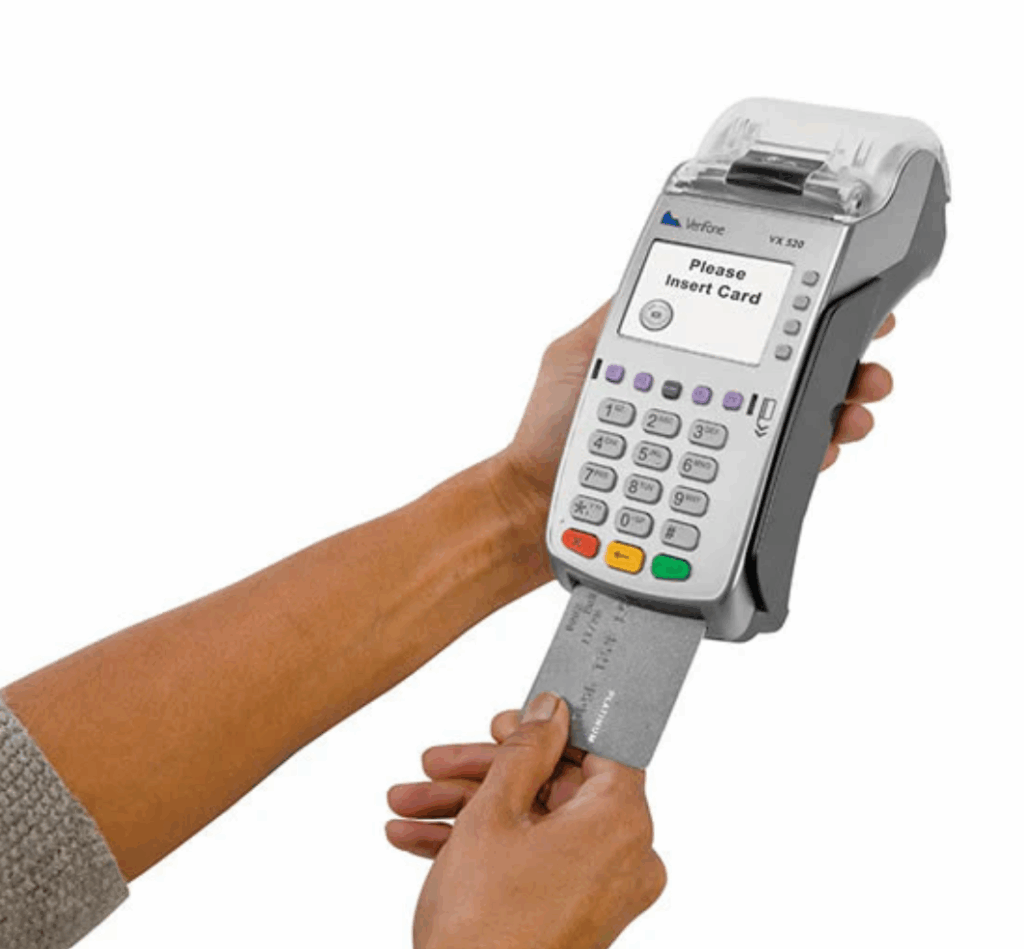
- Description: Stationary devices connected via Ethernet or phone line, typically placed at a fixed checkout counter.
- Features: Reliable for high-volume transactions, supports contactless payments (NFC), chip cards, and magstripe. Often includes receipt printing.
- Cost: $150–$500 upfront or $20–$50/month lease. Transaction fees: 2–3%.
- Best For: Businesses with a fixed point of sale and moderate to high transaction volume.
- Limitations: Not portable; requires power and internet connectivity.
Mobile/Card Readers
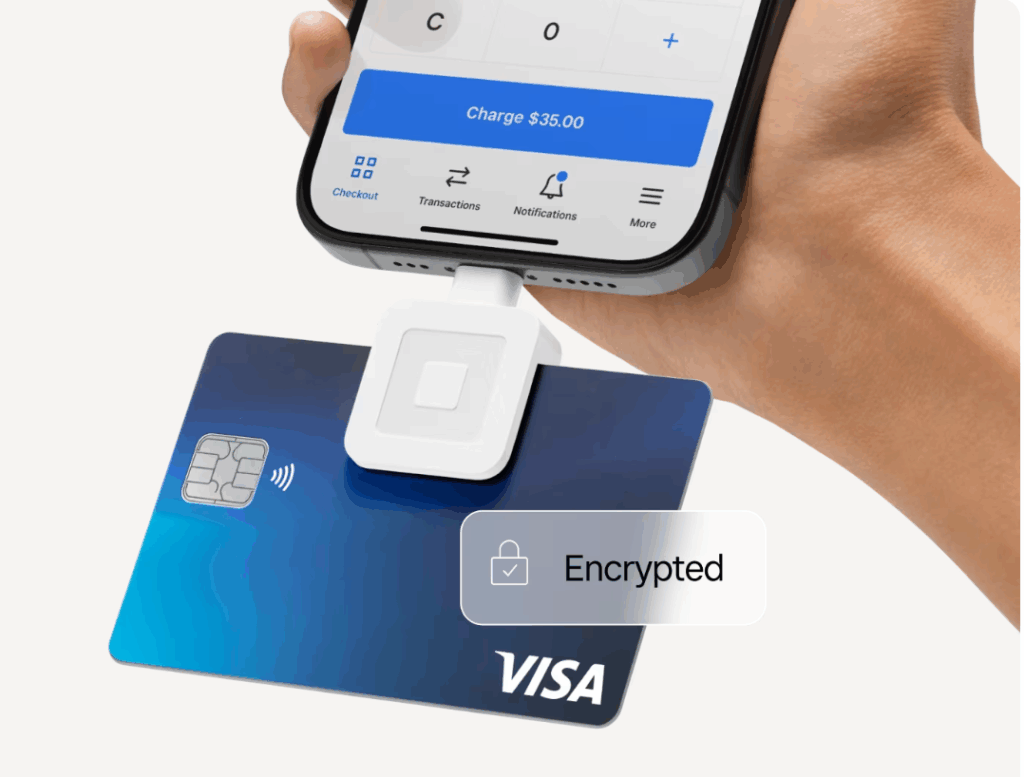
- Description: Compact, battery-powered devices that connect to smartphones or tablets via Bluetooth or audio jack (e.g., Square Reader, PayPal Zettle).
- Features: It supports contactless, chip, and magstripe payments, making it ideal for on-the-go transactions. It is managed via mobile apps with reporting tools.
- Cost: The cost is $10–$100 upfront, and the transaction fees are 2.6–3.5% per swipe. Some providers offer free readers with contracts.
- Best For: Businesses needing mobility or low startup costs.
- Limitations: Limited features for complex needs; reliant on mobile device and internet.
POS Systems
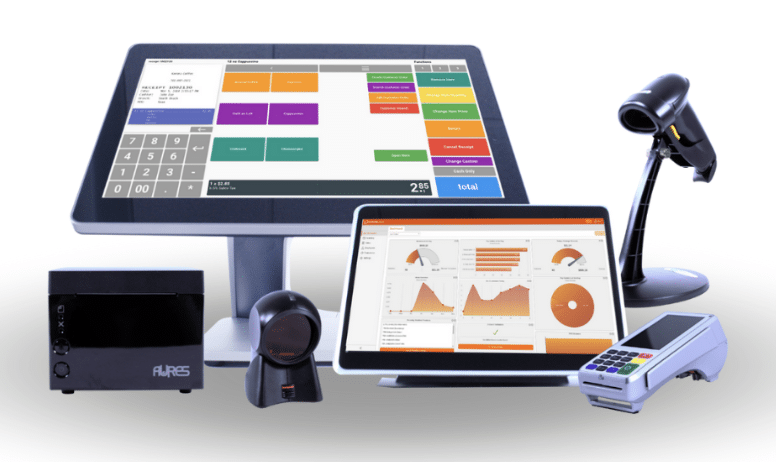
- Description: All-in-one systems integrating payment processing with inventory, sales tracking, and customer management (e.g., Clover, Toast).
- Features: Customizable software, supports multiple payment types, integrates with accounting tools, and offers analytics. Often includes touchscreen displays.
- Cost: The cost is $500–$2,000 upfront or $50–$150/month for a subscription. Transaction fees are 1.5–3.5%.
- Best For: Businesses with complex operations needing robust reporting and integration.
- Limitations: Higher costs; may require training.
Virtual Terminals
- Description: Web-based platforms for processing payments via computer or tablet, often for phone or online orders.
- Features: No hardware needed; supports keyed-in transactions, recurring billing, and invoicing.
- Cost: $10–$30/month subscription; transaction fees: 3–4% (higher due to manual entry).
- Best For: Businesses with low in-person transactions or e-commerce needs.
- Limitations: Not suitable for face-to-face card payments; higher fraud risk.
Wireless Terminals
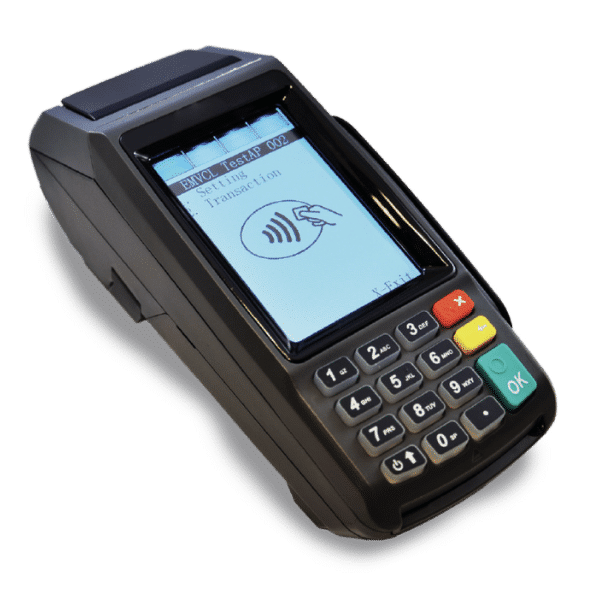
- Description: Portable devices with built-in SIM cards or Wi-Fi for processing payments anywhere.
- Features: It supports contactless, chip, and magstripe payments. It is ideal for businesses without fixed locations or with large premises.
- Cost: The cost is $200–$800 upfront or $30–$70/month on a lease.
- Best For: Businesses needing flexibility without relying on a mobile device.
- Limitations: Battery life constraints; higher upfront costs.
Business Type and Environment
The right credit card machine depends on the type of business you run, its size, transaction volume, and operational needs. Depending on your business, find below the type of credit card machine you might need:
- Retail Stores: Countertop terminals or POS systems (e.g., Clover Mini, Square Stand) for fixed checkouts.
- Restaurants/Cafes: Restaurants thrive with wireless terminals or POS systems for tableside service and order management.
- Mobile Businesses (e.g., food trucks, market vendors): Mobile card readers (e.g., Square Reader, SumUp Air) for portability.
- Online/Remote Businesses: Virtual terminals for card-not-present transactions.
Machine | Example Models | Upfront Cost | Best For | Key Features | Pros | Cons |
Countertop Terminal | Verifone VX 520, Clover Mini | $100–$800 | Retail, medical offices, high-volume | EMV, NFC, receipt printer, reporting | Durable, fast, trusted by customers | Limited mobility, may need internet |
Wireless Terminal | Clover Flex, Verifone VX 680 | $200–$600 | Restaurants, cafes, moderate mobility | Portable, EMV, NFC, offline mode, long battery | Flexible, professional | Higher cost, possible data fees |
Mobile Card Reader | Square Reader, SumUp Air | $0–$100 | Food trucks, pop-ups, low volume | Portable, easy setup, app-based | Affordable, mobile | Smartphone-dependent |
POS System | Square Terminal, Clover Station | $300–$1,800 | Growing retail, restaurants, multi-feature | Inventory, analytics, integrations, EMV, NFC | Scalable, comprehensive | Expensive, complex for small needs |
Virtual Terminal | Helcim, Square Virtual | $0–$50/month | Online, phone orders, remote businesses | No hardware, web-based, e-commerce integration | No upfront cost, flexible | Higher fees, fraud risk |
Built-In POS Terminals vs. Third-Party Processing Hardware
When choosing between built-in point of sale terminals and third-party processing hardware, businesses must weigh the trade-offs in functionality, cost, flexibility, and compatibility. Below is a comparison to help you decide which option best suits your business needs.
Built-In POS Terminals
Built-in POS terminals refer to systems where the payment processing hardware and software are provided as an integrated solution by the same vendor. These systems combine card readers, POS software, and payment processing into a single, cohesive package.
To be sure, POS systems with built-in credit card machines, such as Square or Clover, are a great option for companies such as mom-and-pop stores and food trucks.
However, if you use Square, for instance, then you use Square’s processing. These processing fees can add up to substantial amounts by the end of the year, especially for higher-volume retailers.
Advantages
- Seamless Integration: Built-in terminals are designed to work together, ensuring smooth communication between hardware and software.
- Single Point of Support: With one vendor managing both hardware and software, customer support is streamlined.
- Simplified Setup: These systems often come pre-configured, requiring minimal technical expertise to set up.
- Security Compliance: Vendors often ensure PCI DSS compliance and provide security features like encryption and tokenization.
- Potential Cost Savings: Some providers offer hardware bundles or discounts, and the all-in-one nature can reduce the need for additional integrations.
Disadvantages
- Lack of Vendor Options: Businesses may be tied to the provider’s ecosystem, limiting flexibility to switch processors or POS systems without significant changes.
- Higher Processing Fees: Built-in systems may come with higher transaction fees compared to negotiated rates with third-party processors.
- Limited Customization: These systems may not offer the flexibility to integrate with other software or hardware outside the vendor’s ecosystem.
- Upfront Costs: Advanced built-in terminals, especially those with touchscreen displays or robust features, can have higher initial hardware costs.
- Data Breach Risk: If all customer data is stored in a single system, a breach could expose sensitive information, though proper security measures mitigate this risk.
Find out how much you’re spending.
Third-Party Processing Hardware
Third-party processing hardware uses separate payment terminals or card readers from a different provider than the POS software. The POS system integrates with these terminals to process payments, often through a payment processor like Stripe, Square, etc.
Point of sale systems, such as KORONA POS, are pos credit card processing agnostic, meaning that they will work with any credit card processor.
KORONA POS also offers preconfigured credit card machines and the best customer service support in the industry if you encounter problems with your credit card processing operations.
Advantages
- Flexibility: Businesses can choose the best POS software and pair it with a preferred payment processor, allowing for tailored solutions. For example, KORONA POS is processing-agnostic and works with multiple processors.
- Cost Negotiation: Third-party processors often allow businesses to negotiate lower processing fees or switch providers without replacing the entire POS system.
- Compatibility: Many third-party terminals are compatible with many POS systems, especially cloud-based ones.
- Reduced Vendor Dependency: Using separate providers for POS and processing avoids being locked into one vendor’s ecosystem, offering more freedom to adapt.
- Cost-Effective for Existing Hardware: If a business already owns compatible hardware, third-party processors can integrate without requiring new purchases.
Disadvantages
- Integration Challenges: Ensuring compatibility between POS software and third-party hardware can be complex, potentially leading to errors or delays.
- Multiple Support Points: Issues may require contacting both the POS provider and the payment processor, complicating troubleshooting.
- Higher Maintenance: Businesses may need to manage separate contracts, updates, and maintenance for hardware and software, increasing operational overhead.
- Potential Hardware Costs: If new hardware is needed, costs for terminals or card readers can add up, especially for specialized devices.

Build Your Own POS
Whether you run a retail store, café, or admissions booth, we have the point of sale hardware designed for your specific needs. Start building your ideal POS system now.
How Payment Processors Affect Credit Card Machine Costs
Payment processors significantly influence credit card machine costs through their fee structures. High-fee providers like Square (2.6% + $0.10 per transaction) may offer free or low-cost hardware but charge higher processing rates, increasing overall expenses.
Low-fee providers like Helcim use interchange-plus pricing, reducing transaction costs, but may require purchasing hardware upfront.
Merchant services providers facilitate payment processing, offering hardware, software, and support. Choosing a processor before hardware ensures cost-effective alignment with business needs, as fees often outweigh initial machine costs.
Therefore, it makes the most sense to first compare different credit card processing companies’ fees and then assess what features and support these companies offer when choosing your actual machine.
Different Types of Credit Card Processing Fees
When choosing a payment processor, it’s essential to look out for these processing fees. Ask questions to determine if and when you will be responsible for these charges.
Transactional
These transaction rates are set by the credit card company, issuing banks, and payment processors and gateways, and they vary depending on multiple factors.
Risk is one of these factors; for instance, debit cards with PIN entry cost less per transaction, while purchases made as “card not present” cost more per transaction. A whole host of factors go into the final cost per swipe rate.
Batch Fees
Batching is when the credit card authorizations for a particular business day are finalized and submitted to the payment processor.
Some card processors charge fees for each batch. It’s worth finding out if your processor charges them and what the amount is. Typically, these are avoidable.
Software Fees
For your credit card machine to function properly with your POS, your payment processing company might also charge a monthly software fee.
If so, ask the company to explain what you’re paying for and how it helps your business.
Should You Buy or Lease Your Credit Card Machine?
Deciding whether to buy or lease a credit card machine depends on your business’s financial situation, transaction volume, and long-term goals. Here’s a concise breakdown to help you choose:
Buying a Credit Card Machine
Pros:
- Cost-Effective Long-Term: Purchasing a machine outright avoids recurring fees, saving money over time, especially for businesses with high transaction volumes.
- Ownership: You own the equipment, allowing you to switch providers without being tied to a lease.
- No Monthly Fees: Eliminates ongoing lease payments, which can range from $20-$100/month.
- Tax Benefits: You may be able to deduct the purchase cost as a business expense (consult a tax professional).
Cons:
- Upfront Cost: Requires a higher initial investment, which may strain cash flow for small or new businesses.
- Maintenance/Upgrades: You’re responsible for repairs, replacements, or upgrades as technology evolves (e.g., EMV or contactless payment compliance).
- Obsolescence Risk: Machines may become outdated, requiring future investment.
Leasing a Credit Card Machine
Pros:
- Low Upfront Cost: Minimal initial investment (often just a setup fee), making it easier for startups or small businesses to get started.
- Maintenance Included: Many leases cover repairs, replacements, or upgrades, reducing out-of-pocket costs.
- Access to Latest Technology: Leasing often includes newer models with features like contactless payments or mobile integration.
- Flexible Terms: Some leases allow you to upgrade or cancel (check contract terms).
Cons:
- Higher Long-Term Cost: Monthly payments can add up, potentially costing 2-3x the machine’s purchase price over the lease term.
- Contract Lock-In: Many leases have multi-year terms with hefty cancellation fees, limiting flexibility.
- Hidden Fees: Some providers include unclear fees or inflate costs for supplies/services.
Recommendation
When deciding whether to buy or lease a credit card machine, buying is generally the most cost-effective choice if you have the capital, process a high volume of transactions, or plan to use the machine for several years, as it avoids recurring fees and offers long-term savings.
Conversely, leasing is ideal for new or small businesses with limited funds, low transaction volumes, or a need for flexibility and included maintenance, though you should be wary of inflexible, long-term contracts with hidden fees.
Always compare quotes from multiple providers and calculate the total cost of ownership versus leasing over your expected usage period to make the best decision for your business.
The Actual Cost of Credit Card Machine Hardware: In-Depth Review
When shopping for credit card machines, you’ll likely come across some of the models we recommend. However, navigating online prices can be tricky. Many vendors advertise hardware at seemingly low costs, but these deals often come with a catch.
Reprogramming, downloads, and support will waste a lot of extra time and money, making this type of third-party purchase not worthwhile. Sometimes, it costs more than the machine itself.
Some companies offset discounted equipment prices by charging higher processing fees, which can significantly increase your overall costs. To make an informed decision, carefully compare both the upfront hardware costs and the long-term processing rates.
Look for transparent pricing structures and read the fine print to ensure you’re not locked into unfavorable terms that could affect your profits. You’re much better off contacting processors or point of sale companies directly to find out what credit card machines they offer and at what prices.
As for specific machines, here are some that are commonly recommended:
Machine | Price range | Key Features | Best For |
Dejavoo QD4 | $250–$450 | 5.5” touchscreen, NFC, EMV, WiFi, Android OS, biometric option | Small-medium retail |
Dejavoo Z11 | $250–$450 | 7.5” touchscreen, NFC, EMV, WiFi/Ethernet, PCI PTS v4 security | Retail with moderate volume |
Cayan Genius | $300–$1,000 | Modular, NFC, EMV, integrates with POS, supports multiple payment types | High-volume businesses |
Pax A80 | $200–$365 | 4” touchscreen, NFC, EMV, WiFi/Ethernet, Android OS, optional battery | Small-medium businesses, mobile use |
Pax S300 | $150–$300 | Compact, EMV, NFC, integrates with POS, Ethernet connectivity | Small retail, budget-focused |
Dejavoo QD4 – $250–$450
The Dejavoo QD4 offers a sleek 5.5” touchscreen, NFC, EMV, and WiFi connectivity. Its Android OS ensures ease of use, with optional biometric security. Ideal for small to medium businesses, it supports contactless payments but lacks true wireless mobility. Prices vary based on vendor and PIN pad inclusion.
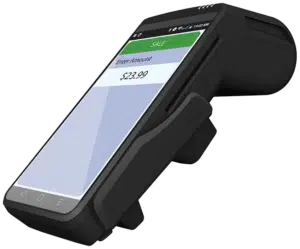
- Built In NFC Contactless Reader
- Quad-Core @ 1.1GHz
- Ethernet, WiFi, USB
- 50 ft. paper roll
Dejavoo Z11 – $250–$450
The Z11 features a 7.5” touchscreen, NFC, EMV, and WiFi/Ethernet connectivity. With PCI PTS v4 security, it’s reliable for retail. It supports digital wallets but faces supply chain issues. Best for businesses needing a robust countertop terminal with moderate transaction volumes.

- Built In EMV and NFC Contactless – EMV 4.x L1 and L2 certified
- Tri-Comm capability (Dial, IP & WiFi)
- Touch Screen Signature
- 2.4’’ Color LCD Screen with backlight
- 192 MB of Memory
- NFC Reader
- SPIn integration
- 32bits 400MHz high speed microprocessor
Cayan Genius – $300–$1,000
Cayan Genius is a modular countertop solution supporting NFC, EMV, and multiple payment types. It integrates seamlessly with POS systems, ideal for high-volume businesses. Prices fluctuate widely due to customization and vendor markups, making it less budget-friendly for smaller operations.

- Online payment gateway
- EMV Payment Processing
- P2PE Validated PCI
- HSA and FSA Card Compatible
Pax A80 – $250 – $450
The Pax A80, a cost-effective Android-based terminal, features a 4” touchscreen, NFC, EMV, and WiFi/Ethernet connectivity. With an optional battery, it doubles as a portable device. Ideal for small to medium businesses, it supports contactless payments and QR codes but has reported customer service issues.
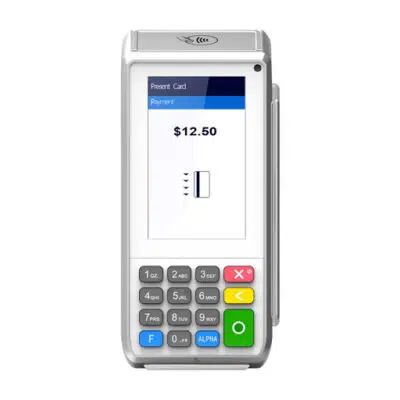
- High Definition 4” Color Touchscreen
- 3.5” per second high-speed Printer
- 0.3 MP Fixed Focus Front Camera
- Multiple Communication Ports
- Wifi, Bluetooth, Ethernet and Dial
- 1GB DDR + 8GB eMMC|1 x Micro SD Card Slot
- Supports up to 32GB
Pax S300 – $150–$300
The Pax S300 is compact, affordable, and supports EMV and NFC. Designed for integration with existing POS systems, it’s perfect for small retailers on a budget. Ethernet connectivity limits mobility, but its low cost and reliability make it a popular choice for cost-conscious businesses.

- EMV®, MSR, and NFC/Contactless
- EMV & PCI Compliant
- Large Memory Capacity
- User-friendly Interface with Powerful GUI
- Color Touchscreen
- Signature Capture
- USB and LAN connectivity options

Build Your Own POS
Whether you run a retail store, café, or admissions booth, we have the point of sale hardware designed for your specific needs. Start building your ideal POS system now.
Must-Have Features in a Credit Card Machine
Familiarizing yourself with credit card technology features and safety standards is a must. Assure that your business is equipped to function optimally and securely now and in the future as your business grows.
PCI Compliance
This is a must for all merchants when choosing their credit card machine. Payment Card Industry Data Security Standard (shortened to PCI DSS, and often just PCI) assures that your credit card machine follows all of the safety protocols to ensure that your transactions are protected from fraud and data breaches. All major credit cards require PCI compliance, and failure to comply with regulations can result in major penalties.
EMV Chip Readers
These are the small square metallic chips on credit and debit cards that are “dipped” into credit card machines. The EMV chip functions in a similar way to the magnetic strip, relaying information about your credit card account to the payment processor.
However, the EMV chip differs in that it creates a single, unique code for each transaction, which helps prevent fraud.
While EMV readers can cost more money up front, they generally save the merchant in the long run through reduced processing fees and fraudulent transaction penalties.
NFC and Contactless
Some of the tech features available now, such as Apple Pay and Google Pay, allow customers to use their smartphone or credit card to hover over a credit card processor to complete transactions.
This “near-field communication” technology is steadily becoming the preferred choice since it offers a fast and easy no-touch solution.
Since more retail experts expect consumers to use these types of mobile payments increasingly in the future, it pays to buy a machine that offers NFC capabilities now.
How to Choose the Best Credit Card Machine for Your Business?
To choose the best credit card machine for your business, assess your transaction volume, budget, and needs.
High-volume businesses may benefit from purchasing a machine to avoid recurring fees, while startups might prefer leasing for low upfront costs and maintenance support.
For future-proofing, ensure the machine supports EMV, contactless payments, and mobile integration. Compare providers for transparent pricing, contract terms, and customer support.
Check compatibility with your POS system and consider portability for mobile businesses. Consult reviews and evaluate long-term costs versus upfront savings to align with your business goals.
Schedule a KORONA POS Demo Today
Speak with a product specialist and learn how KORONA POS can power your business needs.
Final Thoughts on Credit Card Machine Costs
Deciding what credit card machine to use for your retail location can be a bit daunting. Nevertheless, there are people out there to help you with this extremely important business decision.
Reach out to KORONA POS, and we will work with you to figure out the best payment processing and credit card machine options for your business!
We’ll explain various hardware options and costs and even help you understand exactly what you’re paying for with your processing costs. Click below to request a call or product demo.


